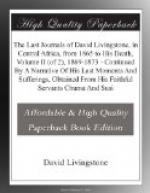25th July, 1871.—We came over a beautiful country yesterday, a vast hollow of denudation, with much cultivation, intersected by a ridge some 300 feet high, on which the villages are built: this is Lobango. The path runs along the top of the ridge, and we see the fine country below all spread out with different shades of green, as on a map. The colours show the shapes of the different plantations in the great hollow drained by the Kunda. After crossing the fast flowing Kahembai, which flows into the Kunda, and it into Lualaba, we rose on to another intersecting ridge, having a great many villages burned by Matereka or Salem Mokadam’s people, since we passed them in our course N.W. They had slept on the ridge after we saw them, and next morning, in sheer wantonness, fired their lodgings,—their slaves had evidently carried the fire along from their lodgings, and set fire to houses of villages in their route as a sort of horrid Moslem Nigger joke; it was done only because they could do it without danger of punishment: it was such fun to make the Mashense, as they call all natives, houseless. Men are worse than beasts of prey, if indeed it is lawful to call Zanzibar slaves men. It is monstrous injustice to compare free Africans living under their own chiefs and laws, and cultivating their own free lands, with what slaves afterwards become at Zanzibar and elsewhere.
26th July, 1871.—Came up out of the last valley of denudation—that drained by Kahembai, and then along a level land with open forest. Four men passed us in hot haste to announce the death of a woman at their village to her relations living at another. I heard of several deaths lately of dysentery. Pleurisy is common from cold winds from N.W. Twenty-two men with large square black shields, capable of completely hiding the whole person, came next in a trot to receive the body of their relative and all her gear to carry her to her own home for burial: about twenty women followed them, and the men waited under the trees till they should have wound the body up and wept over her. They smeared their bodies with clay, and their faces with soot. Reached our friend Kama.
27th July, 1871.—Left Kama’s group of villages and went through many others before we reached Kasongo’s, and were welcomed by all the Arabs of the camp at this place. Bought two milk goats reasonably, and rest over Sunday. (28th and 29th). They asked permission to send a party with me for goods to Ujiji; this will increase our numbers, and perhaps safety too, among the justly irritated people between this and Bambarre. All are enjoined to help me, and of course I must do the same to them. It is colder here than at Nyangwe. Kasongo is off guiding an ivory or slaving party, and doing what business he can on his own account; he has four guns, and will be the first to maraud on his own account.
30th July, 1871.—They send thirty tusks to Ujiji, and seventeen Manyuema volunteers to carry thither and back: these are the very first who in modern times have ventured fifty miles from the place of their birth. I came only three miles to a ridge overlooking the River Shokoye, and slept at village on a hill beyond it.




